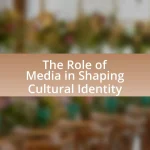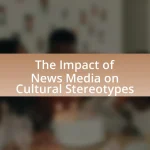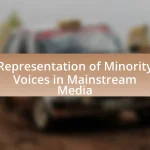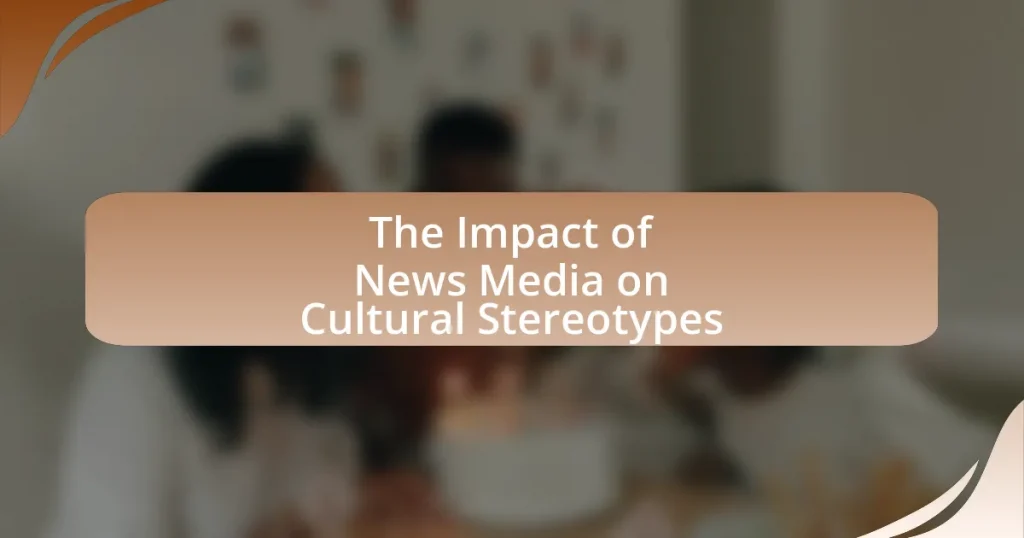The article examines the significant impact of news media on cultural stereotypes, highlighting how media representations shape public perceptions and reinforce existing biases. It discusses the mechanisms through which news media influences cultural narratives, including framing, agenda-setting, and the selection or omission of stories. The role of language and visual elements in perpetuating stereotypes is also analyzed, along with the consequences of sensationalism in news reporting. Furthermore, the article emphasizes the importance of media literacy and responsible consumption to mitigate the effects of biased representations, ultimately advocating for more accurate and diverse portrayals of cultural groups in the media.

What is the Impact of News Media on Cultural Stereotypes?
The impact of news media on cultural stereotypes is significant, as it shapes public perceptions and reinforces existing biases. News media often portrays specific cultural groups in a limited or negative light, which can lead to the perpetuation of stereotypes. For instance, studies have shown that frequent exposure to negative portrayals of minority groups in news coverage correlates with increased prejudice among audiences. Research conducted by the American Psychological Association indicates that media representations can influence societal attitudes, leading to the normalization of stereotypes and affecting the way individuals interact with members of those cultural groups.
How does news media shape public perceptions of different cultures?
News media shapes public perceptions of different cultures by framing narratives that influence audience understanding and attitudes. Through selective reporting, emphasis on specific events, and portrayal of cultural practices, media can reinforce stereotypes or challenge misconceptions. For instance, studies have shown that consistent negative coverage of certain ethnic groups can lead to increased prejudice and fear among the public, as evidenced by research from the Pew Research Center, which found that negative media portrayals correlate with heightened anti-immigrant sentiment. Additionally, the representation of cultural diversity in media can promote acceptance and understanding, as seen in campaigns that highlight multiculturalism and inclusivity. Thus, the way news media presents cultural narratives significantly impacts societal perceptions and attitudes toward those cultures.
What role does framing play in the portrayal of cultural stereotypes?
Framing significantly influences the portrayal of cultural stereotypes by shaping how information is presented and interpreted. Through selective emphasis on certain aspects of a story, media framing can reinforce or challenge existing stereotypes. For example, research by Entman (1993) highlights that framing can lead to the amplification of negative stereotypes by focusing on specific behaviors or incidents associated with a cultural group, while downplaying positive contributions. This selective framing can perpetuate biases and affect public perception, as seen in media coverage of crime, where minority groups are often disproportionately represented in negative contexts, thus reinforcing harmful stereotypes.
How do visual elements in news media influence cultural perceptions?
Visual elements in news media significantly shape cultural perceptions by framing narratives and influencing audience interpretations. For instance, the use of specific imagery, such as photographs or graphics, can evoke emotional responses and reinforce stereotypes. Research by the Pew Research Center indicates that images accompanying news stories can alter viewers’ understanding of events, often highlighting certain aspects while downplaying others, which can lead to biased perceptions of cultural groups. Additionally, studies show that repeated exposure to particular visual representations can solidify stereotypes, as seen in the portrayal of ethnic minorities in crime-related news, which can perpetuate negative cultural associations.
Why is it important to understand the impact of news media on cultural stereotypes?
Understanding the impact of news media on cultural stereotypes is crucial because media shapes public perception and influences societal attitudes. Research indicates that repeated exposure to certain narratives can reinforce stereotypes, leading to biased views and discrimination. For instance, a study by the American Psychological Association found that negative portrayals of minority groups in news media contribute to the formation of harmful stereotypes, which can affect individuals’ self-esteem and societal interactions. Thus, recognizing this impact is essential for fostering a more inclusive and accurate representation of diverse cultures in society.
What are the potential consequences of perpetuating cultural stereotypes in news media?
Perpetuating cultural stereotypes in news media can lead to significant societal consequences, including the reinforcement of prejudice and discrimination. When news outlets consistently portray certain groups in a negative or simplistic manner, it shapes public perception and can foster an environment of bias. Research indicates that exposure to stereotypical representations can influence individuals’ attitudes and behaviors, often resulting in increased hostility towards the stereotyped group. For instance, a study published in the Journal of Communication found that media portrayals of racial minorities as criminals can lead to heightened fear and support for punitive policies against these groups. Additionally, such stereotypes can hinder social cohesion and perpetuate systemic inequalities, as marginalized communities may struggle to gain fair representation and opportunities in society.
How can understanding this impact lead to more responsible media consumption?
Understanding the impact of news media on cultural stereotypes can lead to more responsible media consumption by fostering critical thinking and awareness of bias. When individuals recognize how media representations shape perceptions of different cultures, they become more discerning consumers of information. Research indicates that exposure to diverse narratives can reduce stereotypes; for instance, a study by the American Psychological Association found that individuals who engage with varied media portrayals are less likely to hold prejudiced views. This awareness encourages consumers to seek out balanced perspectives, question the validity of sources, and avoid reinforcing harmful stereotypes, ultimately promoting a more informed and empathetic society.
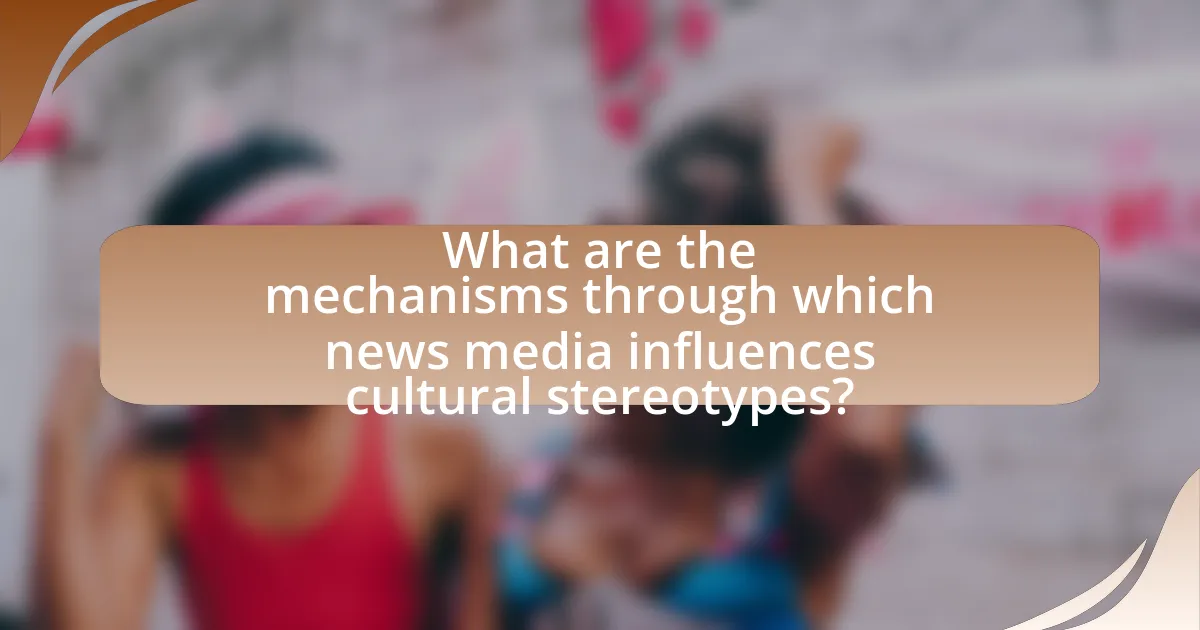
What are the mechanisms through which news media influences cultural stereotypes?
News media influences cultural stereotypes primarily through framing, agenda-setting, and representation. Framing involves the way news stories are presented, which can shape audience perceptions by emphasizing certain aspects while downplaying others. For instance, a study by Entman (1993) highlights how framing can lead to biased interpretations of events, reinforcing existing stereotypes. Agenda-setting refers to the media’s ability to influence what topics are considered important, thereby affecting public discourse and perceptions of different cultural groups. Research by McCombs and Shaw (1972) demonstrated that the issues highlighted by the media significantly shape public priorities. Lastly, representation in news media, including the portrayal of racial and ethnic groups, can perpetuate stereotypes by either reinforcing negative images or failing to provide diverse perspectives. A report by the American Psychological Association (2019) found that negative portrayals in media contribute to the formation and maintenance of cultural stereotypes.
How do selection and omission of news stories affect cultural narratives?
The selection and omission of news stories significantly shape cultural narratives by influencing public perception and understanding of social issues. When certain stories are highlighted, they can reinforce existing stereotypes or create new ones, as seen in the media’s portrayal of racial and ethnic groups, which often emphasizes negative aspects while neglecting positive contributions. For example, studies have shown that the underreporting of positive stories about minority communities can lead to a skewed perception, fostering stereotypes that these groups are primarily associated with crime or poverty. Conversely, the inclusion of diverse narratives can promote empathy and understanding, challenging prevailing stereotypes and encouraging a more nuanced view of different cultures. This dynamic illustrates how media choices directly impact societal beliefs and attitudes, ultimately shaping cultural narratives.
What criteria do news outlets use to select stories that shape cultural perceptions?
News outlets select stories that shape cultural perceptions based on criteria such as relevance, audience interest, and potential impact. Relevance ensures that the story aligns with current events or societal issues, while audience interest gauges what topics will engage viewers or readers. Potential impact assesses how the story may influence public opinion or cultural narratives. For example, a study by the Pew Research Center found that stories covering social justice issues often receive more attention, reflecting their significance in shaping cultural discourse.
How does the omission of certain cultural perspectives contribute to stereotypes?
The omission of certain cultural perspectives contributes to stereotypes by creating a narrow and biased representation of groups, leading to misunderstandings and generalizations. When media outlets fail to include diverse viewpoints, they reinforce existing stereotypes by presenting a singular narrative that overlooks the complexity and richness of different cultures. For instance, studies have shown that news coverage often emphasizes negative aspects of minority communities while neglecting positive contributions, which perpetuates harmful stereotypes. This selective portrayal can shape public perception, influencing attitudes and behaviors towards those groups, as evidenced by research from the American Psychological Association, which highlights how media representation affects societal attitudes and reinforces stereotypes.
What is the role of language in shaping cultural stereotypes in news media?
Language plays a crucial role in shaping cultural stereotypes in news media by influencing perceptions and framing narratives. The choice of words, tone, and context in news reporting can reinforce or challenge existing stereotypes, as seen in studies that demonstrate how specific language can evoke particular images or associations related to cultural groups. For instance, research by Van Dijk (1991) highlights that the portrayal of ethnic minorities often relies on negative descriptors, which perpetuates harmful stereotypes. Furthermore, the use of loaded language can create biases, as evidenced by the differential reporting on crime where certain ethnicities are described with more aggressive language, thus shaping public perception and reinforcing stereotypes.
How does the choice of words influence audience perceptions of different cultures?
The choice of words significantly influences audience perceptions of different cultures by shaping narratives and framing contexts. Specific language can evoke emotions, create biases, or reinforce stereotypes; for example, using terms like “exotic” or “primitive” can lead audiences to view cultures as other or inferior. Research by the American Psychological Association indicates that language shapes thought processes, suggesting that the way cultures are described in media can alter public perception and understanding. Furthermore, studies show that biased language in news reporting can perpetuate negative stereotypes, impacting societal attitudes and behaviors towards those cultures.
What are the implications of biased language in news reporting?
Biased language in news reporting can significantly distort public perception and reinforce cultural stereotypes. When media outlets use biased terminology or framing, they can shape audience attitudes and beliefs about specific groups, often leading to increased prejudice or discrimination. For instance, studies have shown that the portrayal of ethnic minorities in a negative light can contribute to societal stigmas, as evidenced by research from the American Psychological Association, which found that biased media representations correlate with heightened racial tensions and stereotypes. This manipulation of language not only affects individual viewpoints but can also influence policy decisions and societal norms, perpetuating systemic inequalities.
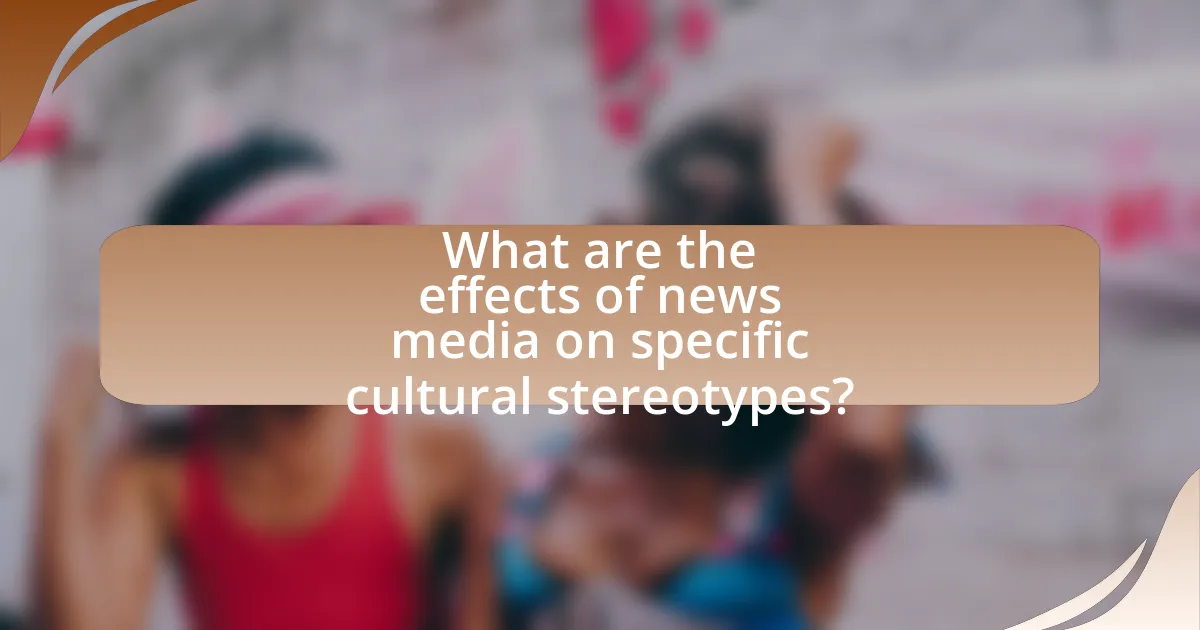
What are the effects of news media on specific cultural stereotypes?
News media significantly influences specific cultural stereotypes by shaping public perceptions and reinforcing existing biases. For instance, studies have shown that the portrayal of ethnic minorities in news coverage often emphasizes negative behaviors, which can lead to the public associating these groups with crime or poverty. Research conducted by the American Psychological Association indicates that repeated exposure to such biased representations can solidify stereotypes, making them more resistant to change. Furthermore, the framing of news stories can either challenge or perpetuate stereotypes; for example, positive representations of diverse communities can help counteract negative stereotypes, while sensationalized reporting can exacerbate them.
How do stereotypes about specific ethnic groups manifest in news media?
Stereotypes about specific ethnic groups manifest in news media through biased representation, selective reporting, and the reinforcement of negative narratives. For instance, studies have shown that minority groups are often portrayed in a limited context, focusing on crime or poverty, which perpetuates harmful stereotypes. Research by the American Psychological Association indicates that such portrayals can lead to public misconceptions and reinforce societal biases, affecting perceptions of those groups. Additionally, the framing of news stories can emphasize cultural differences in a way that highlights stereotypes rather than promoting understanding, further entrenching these views in public consciousness.
What examples illustrate the portrayal of specific ethnic groups in news coverage?
News coverage often portrays specific ethnic groups in ways that reinforce stereotypes, as seen in the reporting of crime and immigration. For instance, studies have shown that media outlets frequently depict Black individuals as perpetrators of crime, while White individuals are often portrayed as victims or heroes. This pattern can be evidenced by a 2016 analysis from the American Psychological Association, which found that Black suspects were overrepresented in crime stories compared to their actual crime rates. Similarly, coverage of immigration often frames Latinx individuals in a negative light, focusing on illegal activities rather than contributions to society. A report by the Pew Research Center in 2019 highlighted that 73% of news stories about immigrants emphasized crime, further entrenching negative stereotypes. These examples illustrate how news media can shape public perception and reinforce cultural stereotypes about specific ethnic groups.
How do these portrayals affect public attitudes towards these groups?
Portrayals in news media significantly shape public attitudes towards various cultural groups by reinforcing stereotypes and influencing perceptions. For instance, consistent negative coverage of specific ethnic groups can lead to increased prejudice and discrimination, as evidenced by studies showing that media representation correlates with public opinion. Research conducted by the American Psychological Association found that exposure to stereotypical portrayals can lead to biased attitudes, demonstrating that media narratives directly impact societal views.
What impact does sensationalism in news media have on cultural stereotypes?
Sensationalism in news media significantly reinforces cultural stereotypes by exaggerating and misrepresenting certain groups. This distortion often leads to the public forming biased perceptions based on sensationalized narratives rather than factual representations. For instance, studies have shown that media portrayals of crime often emphasize racial and ethnic minorities, which can perpetuate negative stereotypes and influence societal attitudes. Research by the American Psychological Association indicates that repeated exposure to such sensationalized content can lead to increased prejudice and discrimination against these groups.
How does sensationalist reporting contribute to the reinforcement of stereotypes?
Sensationalist reporting reinforces stereotypes by exaggerating and oversimplifying complex social issues, leading to distorted perceptions of certain groups. This type of reporting often focuses on negative or extreme examples, which can create a skewed narrative that generalizes the behavior or characteristics of an entire demographic. For instance, studies have shown that media portrayals of crime often emphasize the race or ethnicity of perpetrators, which can perpetuate harmful stereotypes about those groups. Research conducted by the American Psychological Association indicates that repeated exposure to such biased representations can shape public attitudes and beliefs, ultimately solidifying existing stereotypes in society.
What are the long-term effects of sensationalism on cultural understanding?
Sensationalism negatively impacts cultural understanding by promoting stereotypes and fostering misinformation. This occurs as sensationalized news often emphasizes extreme or unusual events, leading audiences to form skewed perceptions of cultures based on limited or exaggerated representations. Research indicates that exposure to sensationalized media can reinforce existing biases, as seen in studies where participants exposed to sensational news reported more negative attitudes towards the depicted cultural groups. Furthermore, sensationalism can create a divide in cultural empathy, as audiences may become desensitized to the complexities of different cultures, viewing them through a narrow lens rather than appreciating their diversity.
What strategies can be employed to mitigate the impact of news media on cultural stereotypes?
To mitigate the impact of news media on cultural stereotypes, media literacy education can be employed as a primary strategy. This approach equips individuals with critical thinking skills to analyze and evaluate media content, enabling them to recognize biased representations and challenge stereotypes. Research indicates that media literacy programs can significantly reduce the acceptance of stereotypes among participants, as evidenced by a study published in the Journal of Media Literacy Education, which found that students exposed to media literacy training demonstrated a 30% decrease in stereotypical beliefs. Additionally, promoting diverse representation in news media can counteract stereotypes by showcasing a broader range of cultural narratives and perspectives, thereby fostering understanding and empathy.
How can media literacy programs help combat cultural stereotypes?
Media literacy programs can help combat cultural stereotypes by equipping individuals with critical thinking skills to analyze and evaluate media messages. These programs teach participants to recognize biased representations and challenge harmful narratives, thereby fostering a more nuanced understanding of diverse cultures. Research indicates that media literacy education can reduce prejudice; for instance, a study published in the Journal of Media Literacy Education found that students who participated in media literacy programs demonstrated a significant decrease in stereotypical beliefs about different cultural groups. By promoting awareness and encouraging critical engagement with media, these programs play a vital role in dismantling stereotypes and fostering inclusivity.
What role do journalists play in promoting accurate cultural representations?
Journalists play a crucial role in promoting accurate cultural representations by investigating and reporting on diverse communities with depth and nuance. Through thorough research and ethical storytelling, journalists can challenge stereotypes and provide a platform for underrepresented voices. For instance, studies have shown that media portrayals significantly influence public perceptions; when journalists highlight positive stories from various cultures, they can reduce bias and foster understanding. Accurate reporting not only informs the public but also holds power structures accountable, ensuring that cultural narratives are not oversimplified or misrepresented.
What best practices can individuals adopt to critically engage with news media?
Individuals can adopt several best practices to critically engage with news media, including verifying sources, cross-referencing information, and analyzing the framing of news stories. Verifying sources involves checking the credibility of the news outlet and the authors, as reputable organizations typically adhere to journalistic standards. Cross-referencing information with multiple sources helps to identify biases and inconsistencies, ensuring a more balanced understanding of the news. Analyzing the framing of stories allows individuals to recognize how language and presentation can influence perceptions, particularly regarding cultural stereotypes. Research indicates that media framing can significantly shape public opinion and reinforce stereotypes, highlighting the importance of critical engagement in media consumption.


